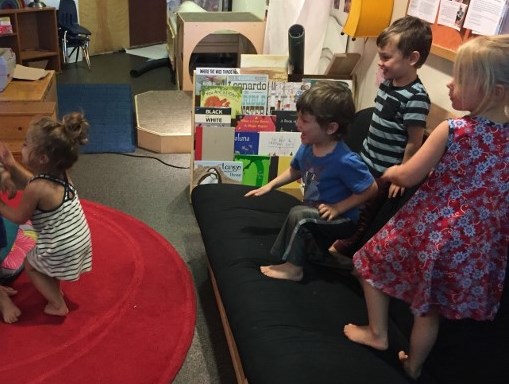
Jumping Into Social Development
by Bria Bloom, Educator, Hilltop Children’s Center
“THUMP!”
The sound of kids playing echoed through the classroom one morning. I turned to see what had made the noise; a kid had jumped from the shelf onto the stage. Other kids turned their heads at the sound of the jump and, knowing that this was a safe place to jump, joined the game. Kids clambered on top of the shelf, watching, waiting, and finally taking their turn to jump.
I watched carefully, and knowing the difficulties of navigating this type of game safely, I gave them reminders such as, “It’s Bee’s turn now, please wait,” and, “please come off of the stage, kids are waiting for their turn to jump.”
With every reminder, I contemplated why I was giving it. Had the kids shown me they needed these reminders? Had anyone jumped into someone else, because they were unable to wait until the stage was clear before launching off the shelf? Did I assume they couldn’t handle the many levels of awareness involved in this play, or did I witness something that showed me that they couldn’t?
I held back the next reminder, to see what would happen if I kept my voice out of their game. I watched kids weave in and out of the game. With all of the activity, negotiation of space, and volume level of the game going on I thought a conflict might occur. However, it didn’t.
Young kids love to jump, and jumping includes all the benefits of physical play. It is good for the developing body and good for the developing brain.
As we delve deep into the world of jumping, we find that there are a lot of challenges and questions for the children to address in group jumping. There are physical challenges: How can I be safe while I’m jumping? How can I jump the highest? Should I bend my knees more? Should I jump from higher up?
There are logical challenges: What objects in this room can I jump off? How can I arrange things to make the landing safer? Should I put down pillows or mats, or can I jump onto grass and still be safe? What about gravel, is that safe to land on?
There are social challenges: What if I want to use this couch to jump from, but someone else is using it? Should I ask them to move, take turns, or push them out of the way? What if I want to jump RIGHT NOW, and it’s not my turn? What if other kids are taking up all the space, or there is someone in my jumping path? What if someone jumps on top of me?
There are also a lot of challenges and questions for the teachers to consider:
- How can we make sure the children are staying safe?
- Will this cause a conflict?
- How do we support the children in navigating all these situations?
As they played this game, all of these, and more, were possible challenges. Some of these challenges they navigated, gracefully, and others didn’t even arise. While 535 highly-paid members of our U.S. Legislature can barely co-exist within their luxurious surroundings, this group of three-year-olds, using primarily non-verbal communication, negotiate a limited space well enough to avoid hurting each other while having a great time. When we as teachers create the space and support for children to take risks, we empower them to take ownership of their learning experiences and to take care of one another through physical play.
[author] [author_image timthumb=’on’]https://hilltopcc.com/wp-content/uploads/2016/02/Bria-bio-photo-e1456787923869.jpg[/author_image] [author_info]Bria Bloom is an educator with 2- and 3-year-olds at Hilltop Children’s Center, where she has worked since 2012.[/author_info] [/author]
2 thoughts on “Jumping Into Social Development”
Comments are closed.
This is a thoughtful and provocative article, Bria. Such an important reminder to support children’s movement and encourage them to take physical risks, but also to trust in their capabilities! I liked how you embedded additional article links to support your argument, too. Here’s a quote I pulled from the article you included about the developing brain: “Scientists now believe that to achieve the precision of the mature brain, stimulation in the form of movement and sensory experiences during the early developing years is necessary”
Thanks for this, Bria. I, like you, often have to bite my tongue and “tolerate” a higher level of both noise and movement because I know it’s worth it. How can I keep going with this to re-train my brain? How can I push back on the [calm + quiet = quality education] equation that’s so ingrained? It’s a daily effort, and one that is sometimes met with conflict from colleagues and parents. I think you captured the situation with your final statement: “When we as teachers create the space and support for children to take risks, we empower them to take ownership of their learning experiences and to take care of one another through physical play.” Yes! More of this! Let’s set the stage (no pun intended) for this necessary active play.